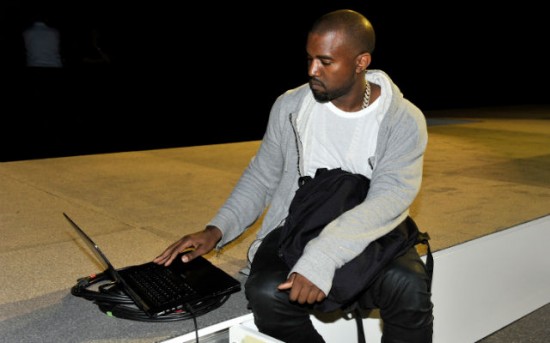Words by Alex Gleckman (@andfeedingyou)
Kanye West has been talking a lot about Steve Jobs lately. The late Apple leader is considered to have been a pioneer in minimalism, from the stripped-down design of Apple products to their iconic white-background commercials. Now is an interesting time for Apple as they move forward, and the debate between skeuomorphic and flat design rages on. Steve was a big skeuomorphic fan, he wanted the software to bear some resemblance to its real-life predecessor—buttons should look like physical buttons, for example, with the intent to make the experience intuitive. Apple has recently taken a turn away from the skeuomorphic in favor of flat design, with Jony Ive at the design helm of the upcoming iOS 7. Now there will be no pine bookshelf to click in order to access your e-books. The embellishments have supposedly been artfully stripped away.
But what would Steve think? There must have been a reason he stuck to the skeuomorphic, and it was because his definition of minimalism included an acknowledgement of the physical world. To strip away all but the essentials, to Steve, meant also keeping a symbolic vestige of an application’s real-life inspiration. The new operating system is supposed to be a complete overhaul in favor of the flat style, but where does one draw the line? At what point is minimalism cutting into the valuable elements of design? At what point in this reduction does the iPhone start to look like, say, the Windows phone?
The same argument applies to rap. Rap can itself be considered an exercise in minimalism, in that it repeats short loops throughout a song—but within that context, a song can take any place on the spectrum between what sounds crisp and what sounds crowded. What does “good” minimalism sound like in rap? To illuminate the subject, let’s look at a couple cases of rap’s minimalist successes with which everyone is familiar.
First, so that we’re all on the same page, think about “Yonkers.” A simple drum-loop, a breathing synth, and just a touch of piano. What the track lacked in extraneous instrumentation was eaten up by Tyler’s then-undeniable lyrical presence. The sparse production put Tyler’s persona in relief, the contrast accentuated his vocals—it made you listen (the same way the white background of an Apple commercial used to make even Justin Long stand out). A good minimalist track allows a good rapper to command it rather than swallowing the rapper’s lyrics in instrumental overkill.
Now, another obvious one: “Grindin’.” Just Neptunes drums. That’s it. This is where Pusha thrives—when there’s room for him to deftly maneuver through the gaps in the beat, weaving in layered coke metaphors as he passes by. Again, less instrumentation meant that you had to pay attention to what was being said, even though Push’s lyrics themselves may lose you along the way, which brings me to my next point: minimalism in vocals. On one side of the lyrical complexity spectrum sits Push, and on the other sit Chief Keef and Future. Keef and Future are perfect examples of the opposite, they often use overwhelmingly crowded beats, but a balance develops due to the lack of complexity in their lyrics. The biggest turn-up point of any song within the last year was Future on the hook of “Bugatti.” And that consisted of a single musical note repeated nine times.
[Click Below For Next Page]


can we get several pages on Yeezus? I lreally enjoyed reading your piece here — thank god you came up after googling Mayback keys. minimalism is a god-send. (btw does “ft” mean f that?). what happens to Al Green after this album? does funky matter anymore? I don’t want to give the man too much power but he put the carcass on stuff. here is somebody devoted to shape. yet he escapes it especially riffing over black bodies swinging in the breeze, gloriously sincere, distended, jazzy — I wouldn’t call that minimalism. the man wants to be loved and frankly it’s a relief after a lot to be feared (BAM — drowning is right). the game feels curiously and appropriately stale in proper context (i.e. minimized — he’s going to come on people, die for his “) because the work is becoming worthy of attention, even rapture (no kidding about fly, something historic happened on this album, especially for those who were introduced to KW with it and don’t have to choke down years of b.s. immunity), for me (who can deny the Philip Roth-hating bitches their day in court?) all the testicular doozies almost get vaginalized after New Slaves — Hamptons blouses and mouths and fur coats and spunk, but did you hear the machinic grist dancing with manic coherence and the need for mother? where did we get this previously, the novelistic tv, heroin juice, Stokely Carmichael, robot John Cage, Trainspotting and Skinny Puppy? reggae oracle done in ways that are painful to contemplate, rivaling William Gibson. think of how boring dance music actually is. who did the music on this album? what clubby sweatshop did they have to endure before the dreamy technophilic actually meant something? swear to god, I love this album. anybody who knows anything remotely as good as this please, I beg you to tell me what it is.